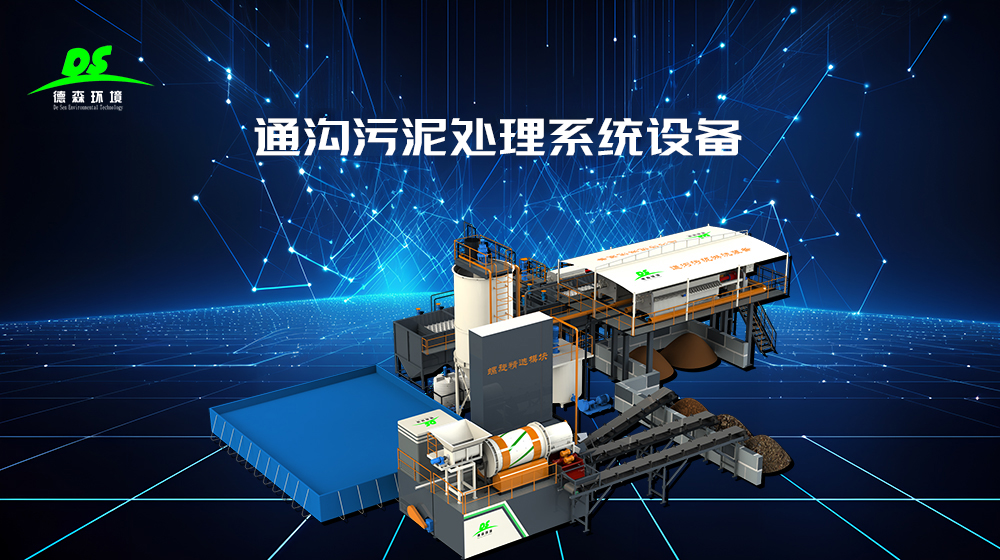Cost reduction and efficiency improvement are visible | Decoding the wealth code of ditch and dredged sludge treatment system
Under the dual pressure of stricter environmental supervision and rising operating costs, municipal sanitation companies are facing unprecedented challenges. How to break through the high energy consumption and low efficiency of traditional treatment models? Desen Environment's newly launched di
Under the dual pressure of stricter environmental supervision and rising operating costs, municipal sanitation companies are facing unprecedented challenges. How to break through the high energy consumption and low efficiency of traditional treatment models? Desen Environment's newly launched ditch and dredged sludge treatment system, relying on technological innovation and circular economy model, not only breaks the technical bottleneck of complex sludge treatment, but also opens up a sustainable development path of "waste-based treatment", becoming the key to breaking the industry.
Ditch and dredged sludge is the sediment of urban drainage network, rich in heavy metals, organic pollutants, pathogens and other harmful substances. Traditional landfill or drying methods not only occupy land, but also have the risk of secondary pollution. With the advancement of the construction of "zero-waste city", sludge treatment urgently needs to transform to reduction, harmlessness and resource utilization. Desen Environment's system decomposes sludge into components such as aggregates, fine sand, organic impurities, etc. through core technologies such as scrubbing classification, multi-stage screening, solid-liquid separation, etc., achieving a resource recovery rate of over 60%. For example, the separated sand and gravel can be used as backfill materials for municipal projects, and organic matter can be converted into fuel or fertilizer, truly turning "pollution burden" into "urban minerals".

The core competitiveness of the Desen system lies in modular integrated design and intelligent control:
Flexible adaptation: Modular equipment can be quickly assembled according to site requirements, support mobile transfer, and save infrastructure costs.
Efficient separation: Through high-pressure scrubbing and multi-stage screening processes, the organic matter separation rate is as high as 50%-70%, and the inorganic sand and gravel recovery rate is more than 90%.
Energy saving and consumption reduction: The whole process adopts gravity flow design, the recycling water rate exceeds 60%, and the single ton of sludge treatment consumes only 4.7 degrees of electricity and 3.8 tons of water, which is 40% lower than the traditional method.
Smart operation: The PLC automation control module realizes "one-button start", real-time monitoring of water and electricity consumption, reduces manual intervention, and reduces operation and maintenance costs by 30%.
In the Nanchang modular ditch and dredged sludge treatment demonstration project, the daily processing capacity of the Desen system reached hundreds of cubic meters, and the sludge moisture content dropped from 80% to below 30%. The separated fine sand and aggregate were directly used for local road construction, saving more than one million yuan in sand and gravel procurement costs annually. The project verified the feasibility of the "waste-to-treatment" model: by feeding back the treatment costs through resource products, the operating pressure of the enterprise was significantly alleviated, and even profit growth was achieved.
The "14th Five-Year Plan" clearly stated that the harmless disposal rate of sludge must reach more than 90%, and the Desen ditch and dredged sludge treatment system not only meets environmental protection requirements, but also meets the "dual carbon" goals through low-temperature pressing, water treatment and reuse and other technologies. For example, the closed-loop water system reduces sewage discharge, and the chemical washing and efficiency enhancement technology reduces the risk of heavy metal pollution, providing a guarantee for municipal enterprises to avoid environmental penalties. In addition, with the shortage of sand and gravel resources, the market demand for sludge recycled aggregates continues to rise, further broadening the profit space.
Desen Environment is promoting the deep integration of ditch and dredged sludge treatment with 5G and IoT technologies, and realizing remote monitoring and data analysis through the intelligent cloud platform to further improve treatment efficiency. In the future, the system is expected to be linked with sewage treatment plants and construction waste recycling networks to form an ecological chain for comprehensive urban solid waste management.





